|
Picasso was born on October 25,1881 in Malaga, Spain as Pablo
Ruiz. He had later adopted the last name Picasso, his mother's
maiden name, as his own. Picasso's father was an art teacher,
who had encouraged Picasso and his artistic talents. He later
attended the Academy of Fine Arts in La Coruna, Spain. In 1895,
the Picasso family moved to Barcelona. There he had attended
the advanced classes of the art academy after completing a one-month
entry examination in one day. Picasso visited Paris in 1900
and traveled to and from there until about 1904. Sometime during
that year he had decided to stay settled in France, where he
tried a variety of modern styles.
|
|
|
The
blue period took place between the years of 1901
and 1903. During this time Picasso started his
unique style of art. The sad figures in the art
works showed compliance with their social class.
No one really knows why Picasso chose the color
blue for his paintings. Some believe that it was
the bluish tinge of photographs (that was often
used in that period) while others think it was
because blue is associated with sadness.
|
|
|
In
1904, the rose or as some say the circus period
began. Picasso focused on the social outcast
status of circus performers. In this period
he used lighter and warmer colors.
Throughout
this period he also met a woman by the name
of Fernande
Olivier. She appeared in numerous
paintings that he made.
|
|
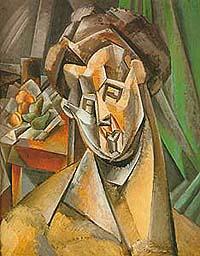
Donna con le pere (Fernande)
1909, 92 x 73 cm
private collection, New York |
|
In 1905, Picasso
begins to drift away from the emotionally attached paintings
like those done in the blue and rose periods.
The main colors used at this time were beige and light brown.
His attention focuses more on form, which is displayed in his
classical sculptures.
In 1906, he becomes interested particularly in Iberian sculptures,
which were native to Spain.
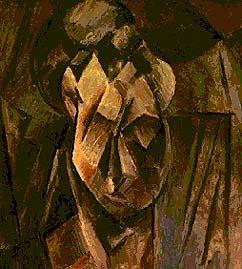
Tête De Femme, 1910 |
|
Inspired
mostly by Paul Cezanne, Picasso and the French
artist Georges Braque worked together to create
the first phase of cubism, analytical cubism. Between
1908 and 1911 the two were greatly interested in separating
and analyzing various forms. In 1912, Picasso glued
objects such as paper and cloth to his canvas. Then
he would add paint to the picture creating a collage.
This artwork led to the next phase, synthetic cubism.
Synthetic cubism was more ornamental and the colors
used played an important role. At the left is the picture,
Tête De Femme, which was painted
during the cubist period.
|
In 1912, Picasso began to use construction in his sculptures.
He used materials such as wood, string, and other everyday objects.
Picasso extended the definition of art by combining artistic
and non-artistic materials together. During this time Picasso
had broken up with Olivier and met a new lover, Eva Gouel.
Gouel had passed away in 1915. At some point during World War
I, Picasso traveled to Rome as a designer. There he had met
and married Olga Koklova. He painted numerous portraits
of her and their child, Paulo, in a realist style. Throughout
this period he had also painted calm pictures of sculpture-like
figures and pictures inspired by mythology. Picasso also created
aggressive portraits of women and bizarre pictures of small-headed
bathers. Some believe that he produced this kind of art due
to the stress in his marriage. Even though Picasso stated that
he was not a surrealist, many of his pictures had disturbing
and surreal qualities.
Between the years
of 1920 and 1925, Picasso gave more attention to the three-dimensional
forms and classical themes. Examples of this, which can be found
in his paintings, are bathers and women in drapery. The figures
in the artworks are shown as large and heavy.
 Le Rêve ("The Dream"), 1932
Le Rêve ("The Dream"), 1932 |
|
From about 1925 until 1936, Picasso designed paintings
with geometric shapes. The main colors used during this
time were red, blue and yellow. Some paintings illustrated
female figures with their mouths hung open and teeth
that were frightening. At this time Picasso's marriage
was breaking up and it is believed that the figures
represented Koklova. Picasso tried working with welding
in his sculptures around this time also. Many of his
works included his new companion Marie-Thérèse
Walter. The couple had a daughter in 1935 named
Maria.
|
| In 1936,
Picasso met Dora Maar who became his new companion,
despite the fact he was still with Walter. In 1937, the
Spanish government wanted Picasso to paint a mural for
Spain's exhibition in Paris. The idea of Guernica
came to mind when Picasso had heard that the Nazi planes
had bombed the Spanish town. Picasso described the bull,
which is on the left of the painting, as being the symbol
of brutality and darkness. There is an injured horse,
in the center, which is believed to represent the Spanish
people. An exploding light bulb, which is located in the
center at the top, is seen as air warfare. Figures of
people dying observed on the front represent the inhumanity.
|
|
|
|
During
World War II, Picasso remained in Paris. His paintings
throughout this time reflected the uneasiness of the
war. Creations such as Head of a Bull (1943),
are a little lighthearted and unusual. In this particular
sculpture a bicycle seat and handlebars were used to
make the bull's head. Picasso joined the Communist Party
at the time of the war and afterwards he had attended
peace conferences.
|
|
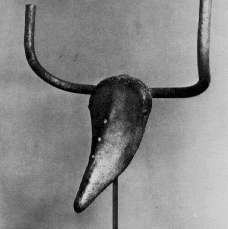 Bull's Head
Bull's Head
1943; 16 1/8" high
Handlebars and seat of a bicycle |
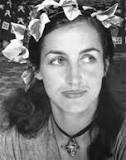 |
|
In the 1940s
Picasso met Françoise
Gilot, a French painter, while still in a relationship
with Maar. They had a daughter, Paloma, and a son, Claude.
Both children appear in Picasso's later artworks. The
couple broke up in 1953 and Picasso married Jacqueline
Roque in 1961. Around this time Picasso took works from
past artists and modified them into his own style. This
method was scarcely done by other artist because it was
thought to be unoriginal work. However, in the 1970s other
postmodern artists started to utilize famous works by
earlier artists for their own creations. |
|
Due to Picasso's originality
he is considered to be the most influential and well-known
artist of the 20th century. He had numerous
followers of his great works as well as admirers. One
of his late creations was a 50 feet tall sculpture of
welded steel. The masterpiece, Head of a Woman,
was a gift to Chicago. It stands in the front of Chicago's
Civic center and it is now a city landmark.
|
|
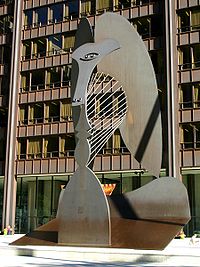 Daley Plaza, Chicago, 1967, 50'
Daley Plaza, Chicago, 1967, 50' |
WORKS CITED
"Picasso,
Pablo Ruiz y," Microsoft® Encarta® Online Encyclopedia 2001
http://encarta.msn.com © 1997-2000 Microsoft Corporation. All
Rights Reserved.
http://www.artchive.com/artchive/P/picasso_blue.html
|